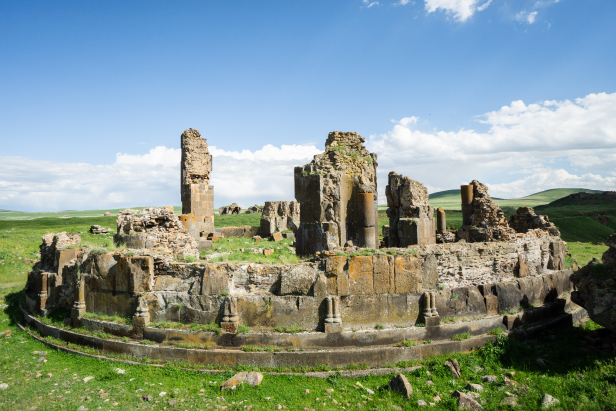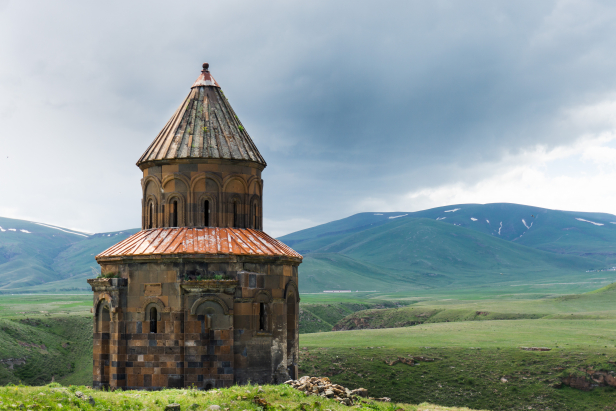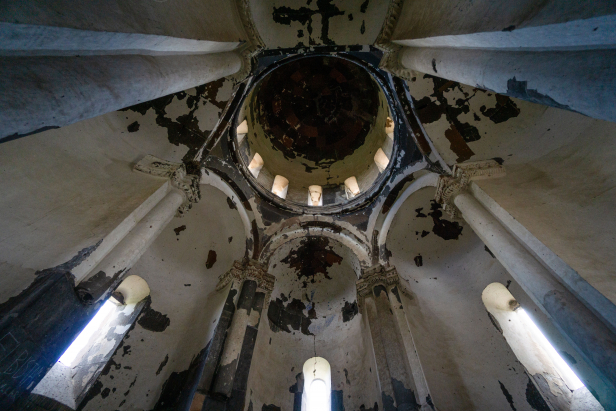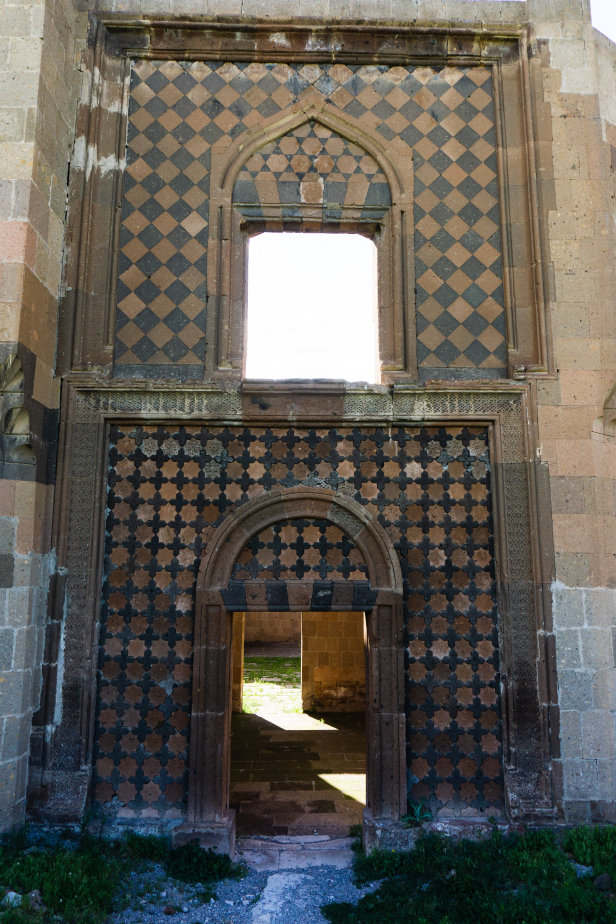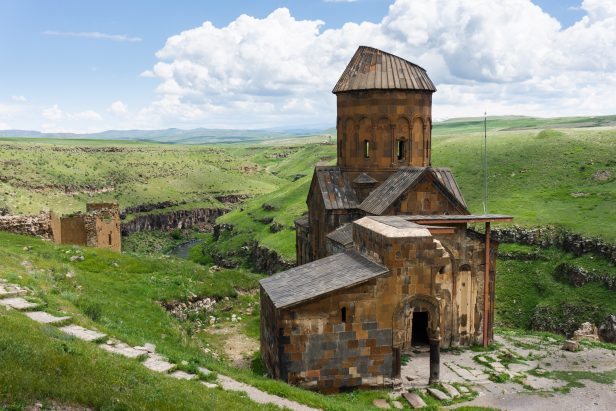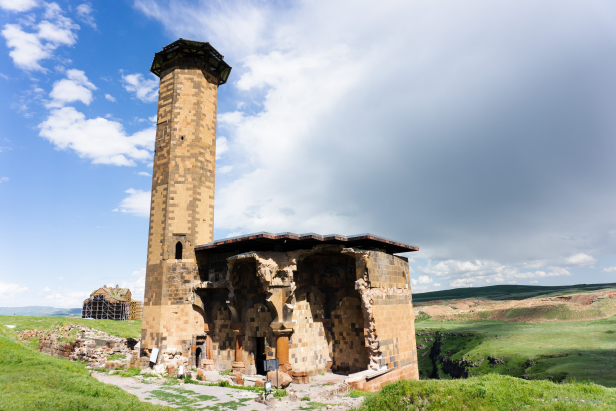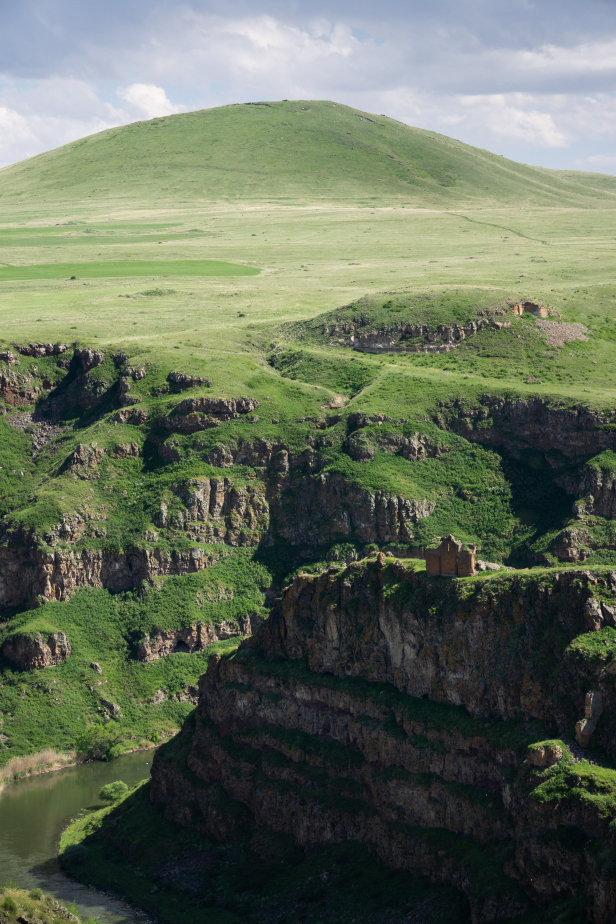The Ruined City of Ani
Ani Ören Yeri
/ By Josh
Cost: 10TL
Müze Card accepted
Great for: Church Architecture, Armenian History, Seljuk History, UNESCO, People named Greg
NOTE: While in the past special permission was required to enter Ani, this has not been the case for some time now and only a couple remote sections are closed.
On a secluded plateau in the far reaches of Turkey’s north east lies the regions most impressive destination. The medieval city of Ani is a stunning blend of natural beauty, history, and architecture. Ani’s ruinous monuments of copper and black stone rise out of a sea of green (or white if you visit during Kars’ long hard winter) on a long wedge of land surrounded by deep gorges and towering fortifications. So far from Turkey’s normal touristic centres and the hordes of tourists that visit them, Ani’s greatest charm may be the haunting feeling of seeing the remains of such a great city turned into silent fields with only the odd traveler making the trip to explore this magnificent place.

Known as the city of 1001 churches, the incredible wealth and power of this ancient Armenian city is still showcased in the unique architecture of its people. Ani is arguably the best example of historic Armenian art and culture, a fact that helped secure its place on the UNESCO list of World Heritage Sites. With hundreds of years of ever-shifting borders, the remains of the once great city now lie just within the Turkish border with Armenia, divided by the deep gorge of the Arpaçay river.
Subscribe to The Art of Wayfaring

Why Visit?
While there are many more sights at Ani than what we list here, this is an introduction to all the must-see monuments in Ani.
(For the history of this amazing city see the summary below the list of must-see sights)
THE CITY WALLS
The first sight that a visitor to Ani will be met with is the imposing double wall built across the northern edge of the city; the only part of the city not protected by high cliffs. The great walls were originally built around 1000 AD though they were added to repeatedly over history. Many Towers were also added later as wealthy families sponsored the building of new towers.
The historic walls were built primarily of orange stone with sections accented in black, sometimes appearing like a chequered board. Recently large portions of the walls have been roughly restored with a much paler stone; these lack the patterns that were originally there.


ANI CATHEDRAL
Excluding the city walls, the largest surviving structure left in Ani is the great Ani Cathedral built during the height of the city’s power and named for Mary Mother of the Christ. While the cathedral may look simple from a distance this is for two reasons. The main reason is that the once great conical dome that stood thirty-eight metres high was lost to an earthquake. With its lofty arches set on top of tall, narrow, clusters of columns it’s been argued that Ani Cathedral may have helped inspire the Gothic movement that came to define the greatest medieval cathedrals of northern Europe.
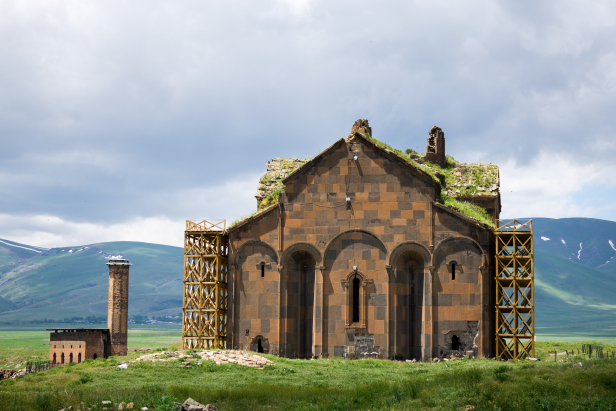
After the city was conquered by the Seljuks in 1064 Ani Cathedral was converted into a mosque and called ‘Fethiye’, referring to the conquest of the city. Whenever Christians took control of the city it was again converted into a church; changing back and forth through the years and wars.

THE CHURCH OF ST GREGORY OF KING GAGIK
Little remains of the grand church commissioned by King Gagik although a visit to the site can give you an impression of the incredible size of the building.
King Gagik’s church was built in the style of Zvarnots Cathedral in Armendia which was supposedly built on the site of the meeting of the Armenian King Tiridates and St Gregory the Illuminator, the pair credited with the official conversion of the Armenian people to Christianity in 301.
The design of the church was incredibly ambitious with lofty vaults centred upon a high dome set in a circular building. Unfortunately the project proved to be a little too ambitious and the buildings massive dome collapsed within a few decades of its completion. Before excavations in 1905 Gagik’s church was little more than an earthen mound.
CHURCH OF THE TWELVE APOSTLES/CARAVANSERAI
Depending on what sign, guidebook, or website you read, this building will either be listed as a caravanserai (something of a fortified hotel for caravans) or as the Church of the Twelve Apostles. Depending on what era you look at, both may be true.

While the originally date is unknown, the earliest date found on the building is from 1031. It is thought that the church was converted into a caravanserai by the Seljuks after they took the city some three decades later. However, this is debated, and the building is far too small to have been very practical as a caravanserai. Some design elements certainly reflect Seljuk architectural styles (specifically the entry and dome) though these too are covered in Armenian inscriptions. Make sure to see the magnificent black and orange patterned stonework in the ceiling of the remaining part of the building. The stalactite dome is also possibly the best example of Seljuk styled architecture in Ani.
THE CHURCH OF ST GREGORY OF ABUGHAMRENTS
With its tall dome and round exterior the Church of St Gregory of Abughamrents is one of the best preserved and most interesting churches in Ani. From a distance it appears to be a simple round building capped with a conical roof on a raised drum. In reality, the round exterior is 12 sided with alternating small windows and deep niches cut into the masonry. On the interior are six deep-set, round apses set around a central circle (below the main dome) much like rounded petal on a daisy. Don’t skip this deceivingly beautiful building!
THE SELJUK PALACE
In the north-western corner of the city, not far from the end of the massive walls is what is commonly referred to as the Seljuk Palace though other sources will call it The Sultans Palace, The Merchants Palace etc. While the palace was certainly a beautiful piece of medieval architecture it now serves as an example of well-intentioned restoration doing more harm than good.
There is almost nothing left of the original and all historic character has been lost except in the beautiful entrance with its beautiful patterns of interlocking black and orange stones. Sadly, even this entryway is new as most of the original stones had fallen off and been taken as souvenirs.
THE CHURCH OF THE REDEEMER
One of the most iconic ruins in Ani is the half-collapsed Church of the redeemer. The church, built around 1030, stood more or less intact until a lightning storm in 1957 caused half of the tall cylindrical church to come crashing down in the night. While today the dome is quite round the original was conical like most of the monumental buildings in ancient Armenia.
To keep the building from collapse the remains of the church have been filled with heavy supporting scaffolding. While this hides the beauty of the building and the remains of the frescoes, it’s an essential step to prevent this monument from being lost completely.
THE CHURCH OF ST GREGORY OF TIGRAN HONENTS
Built in 1215, only a few decades before the Mongols sacked the city, Ani was to become one of the last great monuments built in the city. Perched on the edge of the deep ravine that protects the eastern edge of the city, Tigran Honents is one of Ani’s most iconic buildings. The exterior is covered in lengthy inscriptions and decorated with depictions of animals, people and grape vines (the grape vine is a common motif in Christianity).
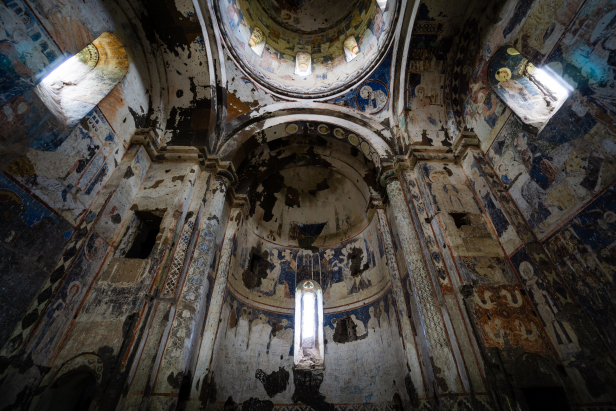
The interior of Tigran Honents was completely covered in frescoes and now holds Ani’s best-preserved frescoes. While heavily damaged by time, weather, and graffiti, you can still see the colourful depictions of saints and figures from Armenian and Biblical history.
MENÜÇER MOSQUE
Built in 1072 by the Seljuk Turks after they conquered Ani, Müneçer Mosque was built like many of Ani’s other great buildings; right on the edge of the cliff. The main attraction to the mosque is the beautiful, orange and black, octagonal minaret that towers over the rest of the building. Set with orange stone on the side of the minaret is the Arabic word “Bismillah” meaning “In the name of Allah”.
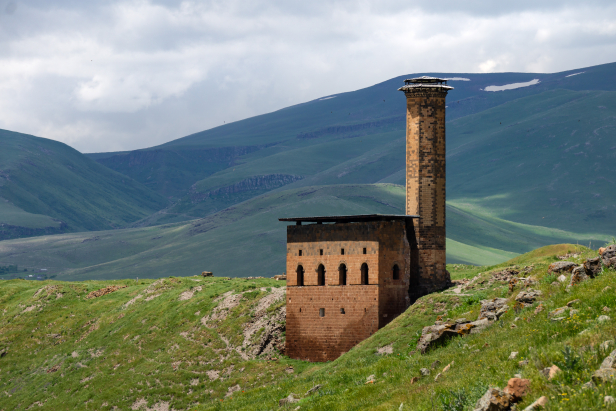
The building underwent many stages of expansion and destruction and so very little of the original mosque is left today and the layout hardly resembles a normal mosque.
In the early 1900’s Müneçer Mosque was repaired to house a short-lived museum established by Russian and Armenian archaeologists.
THE INNER CASTLE
At the southern point of the city is a tall grassy mound that was once the inner castle, or royal citadel. The citadel housed a palace, three churches, and heavy fortifications. While this site was excavated and partially restored in the early 1900’s there is little left to see today though the view is absolutely stunning. (Some older guidebooks will show that the inner castle is closed, it’s now freely accessible.)
MAIDENS CASTLE
South of the Inner Castle is one of Ani’s most iconic sights. Known as the Maidens Castle, a small monastery sits perched on a great cliff-faced rock surrounded by a bend in the river below. The monastery at the Maidens Castle was the final place to be abandoned sometime in the 1700’s when the last monks left. The monastery is best viewed from the lower end of the Inner Castle by the remains of the small chapel.
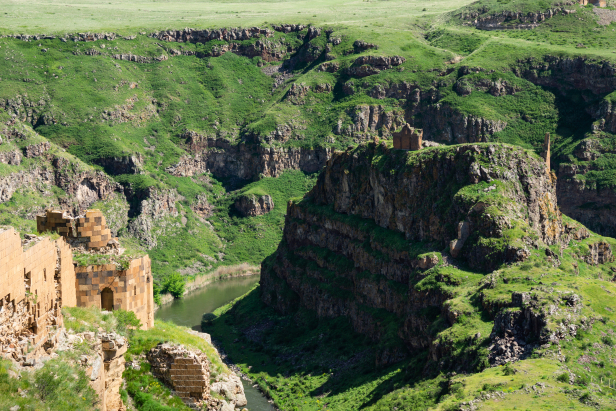
AND…
Beyond these main sights you’ll find the remains of a pre-Christian Zoroastrian fire temple, a pair of ruined bath houses, streets lined with shops, the remains of a bridge, more churches, and countless dwellings built to house the massive population. Outside the city walls you’ll find valleys lined with cave dwellings, thought to have been built when space within the city walls began to run short. Today these are mostly used as barns and sheds.
Be sure to catch a glimpse of the Convent of the Virgins hidden deep in the valley somewhere below the midpoint between Tigran Honents and Müneçer Mosque. Surrounded by high cliffs with a river below The Convent of the Virgins is one of the more picturesque sights in Ani.

HISTORY OF ANI
Inhabited since the Bronze Age, Ani doesn’t enter recorded history till the 5th century AD and reached a peak of power, culture, and wealth around 1000 AD. It was during this time that Ani became a regional capital and the majority of Ani’s great monuments and hulking city walls were built. While its power was to be relatively short lived, Ani is believed to have been home to around 100,000 residents and to have even eclipsed Constantinople in wealth and influence.
In 1064 the armies of the Seljuk Turks sacked the city, killing thousands of the residents. Governance of the city was then given over to ethnically Kurdish rulers who sought to have better relations with their majority Christian subjects.

The city then went through various stages of being ruled by various factions. Some were invited to take the city, such as the Christian kingdom of Georgia, and others uninvited such as the great conqueror Tamerlane, the Karakoyunlar, the Persian Safavids, and finally the Ottoman Turks. In 1236 the city was brutally sacked by the Mongols and in 1319 a violent earthquake sealed the fate of the once great city and Ani was reduced to a village. In the 1700’s the last residents, monks in the remote Maidens Castle, left their monastery and Ani was completely abandoned.
In the 1900’s, as a part of the Russian Empire, archaeological excavations were undertaken by Russian Armenian Archaeologists and historians. With the collapse of the Russian and Ottoman Empires the borders were redrawn and Ani fell inside Turkish territory though the majority of the finds uncovered in Ani were taken to Armenia where they are now on display.
Unfortunately Ani’s misfortunes continued well into modern times when lightning strikes, earthquakes, blasts in Armenian quarries, the malevolence of the Turkish Army, and some poorly executed restorations have caused great damage to the monuments of Ani. Ani has been listed as one of the sites most at risk of disappearing if protection and preservation efforts aren’t undertaken. A good sign of a positive future for Ani came in 2016 when Ani was entered into the UNESCO World Heritage Sites list.
Visiting Ani is not only an amazing experience for you but it helps finance the preservation of this one of a kind place for future generations.
How To Get There
General
To Kars:
The city of Kars, as a provincial centre, has fairly good transit connections to most of Turkey’s other major cities.
Coach busses run regularly from all over the country to Kars.
Kars has an airport though flights are somewhat less frequent compared to other cities. There are direct flights from Istanbul and Ankara though if you fly from anywhere else in the country you will most likely connect through Ankara.
One of the most popular routes to Kars is the Doğu Ekspresi (Eastern Express) train route from Ankara to Kars via Erzurum. The word ‘Express’ is used rather loosely, and the journey is a slow one. The Eastern Express owes its popularity to the fact that the route is stunningly beautiful rather than quick.
From Kars to Ani:
From The city of Kars to the Ani Ruins Open Air Museum you have a few options:
Private Car: By car it’s a simple 43 km drive east out of the city along the Kars Yolu (Kars Road) following the brown signs marked Ani.
For more about car rental and driving in Turkey make sure to read our full drivers guide.
Taxi: At 43 kms away the taxi fair will not be super cheap (Though if you’re converting your money from foreign currency like USD or Euros then it will still be quite cheap) also you’ll need to arrange for a taxi back from the site and pay the driver to either wait or come back for you however many hours later. If you’re a group of three or four then this may still be a great option.
Minibus: By far the cheapest option the minibus costs 14 lira round trip. During the high season there is a morning trip and an afternoon trip allowing for 2 hours of wandering the Ani ruins. While it’s possible to see all of Ani in 2 hours you’ll need to be fast. If you want more time, make sure to arrange to return on the afternoon bus instead.
Tour agency: Private tour agencies and guides will arrange transit as well as serve as a guide to the site itself. This is a great option for larger groups as they’ll be able to arrange for vans or private minibuses to get you to the site. Booking a guide online seems to be a bit challenging so it may be best to ask at the reception at your hotel as many hotels will have some sort of connection to guides and the local tour agencies.
Where To Stay
The village on the outskirts of Ani (called Ani or Ocaklı) is tiny and has no accommodation options beyond camping in a field. Your best bet by far is to get a hotel in the nearby city of Kars (50 km away) where there are lots of good quality, reasonably priced hotels in the centre of the city.
Other Tips
The best time of year to visit Kars and Ani is in the late spring (May – June) when the grass is green, the weather warm, and there’s still snow on the mountains. The winter is also an attractive time to visit the province of Kars in general and Ani will be blanketed in snow. If you come in the winter be prepared for temperatures reaching as low as -20 degrees Celsius and sometimes even lower.
Have any tips or info to add? Spot any mistakes? We’d love to hear about it.
